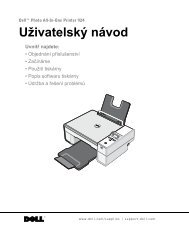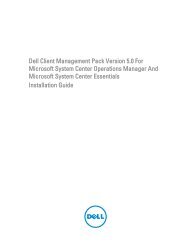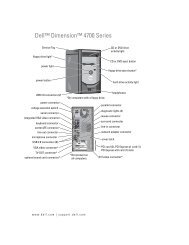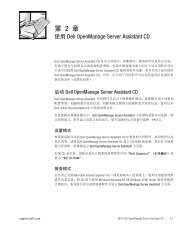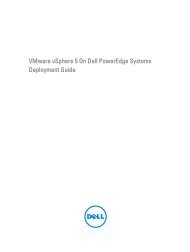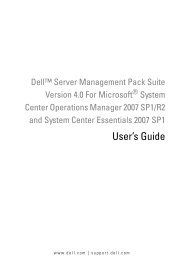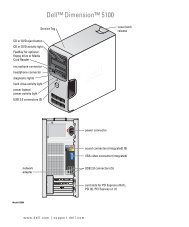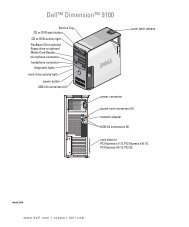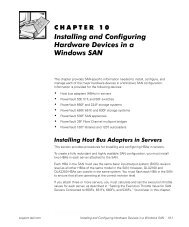Dell OpenManage Server Administrator User's Guide - Dell Support
Dell OpenManage Server Administrator User's Guide - Dell Support
Dell OpenManage Server Administrator User's Guide - Dell Support
You also want an ePaper? Increase the reach of your titles
YUMPU automatically turns print PDFs into web optimized ePapers that Google loves.
NOTE: The default SNMP agent configuration usually includes a SNMP community<br />
name such as public. For security reasons, rename the default SNMP community<br />
names. For information about renaming the SNMP community names, see the<br />
appropriate section below.<br />
NOTE: SNMP Set operations are disabled by default in <strong>Server</strong> <strong>Administrator</strong><br />
version 5.2 or later. <strong>Server</strong> <strong>Administrator</strong> provides support to enable or disable<br />
SNMP Set operations in <strong>Server</strong> <strong>Administrator</strong>. You can use the <strong>Server</strong><br />
<strong>Administrator</strong> SNMP Configuration page under Preferences or the <strong>Server</strong><br />
<strong>Administrator</strong> command line interface (CLI) to enable or disable SNMP Set<br />
operations in <strong>Server</strong> <strong>Administrator</strong>. For more information about the <strong>Server</strong><br />
<strong>Administrator</strong> CLI, see the <strong>Dell</strong> <strong>OpenManage</strong> <strong>Server</strong> <strong>Administrator</strong> Command Line<br />
Interface <strong>User's</strong> <strong>Guide</strong>.<br />
NOTE: For IT Assistant to retrieve management information from a system running<br />
<strong>Server</strong> <strong>Administrator</strong>, the community name used by IT Assistant must match a<br />
community name on the system running <strong>Server</strong> <strong>Administrator</strong>. For IT Assistant to<br />
modify information or perform actions on a system running <strong>Server</strong> <strong>Administrator</strong>,<br />
the community name used by IT Assistant must match a community name that<br />
allows Set operations on the system running <strong>Server</strong> <strong>Administrator</strong>. For IT Assistant<br />
to receive traps (asynchronous event notifications) from a system running <strong>Server</strong><br />
<strong>Administrator</strong>, the system running <strong>Server</strong> <strong>Administrator</strong> must be configured to<br />
send traps to the system running IT Assistant.<br />
The following procedures provide step-by-step instructions for configuring<br />
the SNMP agent for each supported operating system:<br />
• “Configuring the SNMP Agent for Systems Running <strong>Support</strong>ed Windows<br />
Operating Systems" on page 29.<br />
• “Configuring the SNMP Agent on Systems Running <strong>Support</strong>ed Red Hat<br />
Enterprise Linux" on page 32.<br />
• “Configuring the SNMP Agent on Systems Running <strong>Support</strong>ed SUSE<br />
Linux Enterprise <strong>Server</strong>" on page 36.<br />
• "Configuring the SNMP Agent on Systems Running <strong>Support</strong>ed VMware<br />
ESX 4.X Operating Systems to Proxy VMware MIBs" on page 39.<br />
• “Configuring the SNMP Agent on Systems Running <strong>Support</strong>ed VMware<br />
ESXi 4.X and ESXi 5.X Operating Systems" on page 41.<br />
28 Setup and Administration




